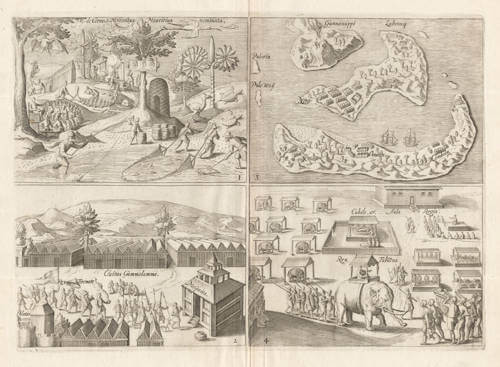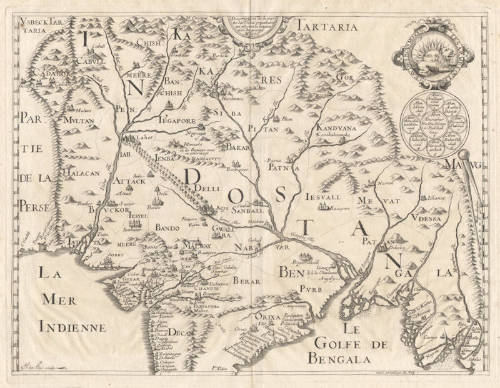Leen Helmink Antique Maps
Hulsius' map of the Dutch first fleet to the East Indies
Stock number: 19591
Zoom ImageTitle
INDIA ORIENTALIS
First Published
Nuremberg, 1602
This Edition
1602 first and only edition
Technique
Condition
excellent
Price
$ 7,500.00
(Convert price to other currencies)
Description
Levinus Hulsius' extremely rare map of the Indian Ocean and the Far East, including the northern tip of undiscovered Australia. Lacking in nearly all collections.
The map is signed and dated in the lower right: Per Levin Hulsium Anno 1602.
Interestingly, the map is a lifesize "carbon" copy of the corresponding part of Cornelis de Houtman's forbidden overview chart of the route of the first Dutch fleet to the Indies, published by Cornelis Claesz in 1598 but immediately banned by the authorities. This proves that Levinus Hulsius did use the most up-to-date sources for his work.
Levinus Hulsius (c.1550-1606)
Levinus Hulsius (c. 1550–1606) was a notable figure in the late 16th and early 17th centuries, recognized for his contributions as a publisher, printer, linguist, lexicographer, and dealer of fine scientific instruments. Born in Ghent, Flanders, Hulsius pursued studies in languages and mathematics. Due to religious conflicts, he relocated to the Netherlands and later to Germany, where he established his career.
Eight years after Theodor de Bry began the publication of his Great Voyages', Levin Hulsius, stimulated and inspired by the success of the Bry's work, began the publication of a similar collection in quarto.
Like Theodore de Bry, Hulsius is renowned for abridging and translating early accounts of voyages and travels into the German language, published ultimately in twenty-six volumes. As with de Bry, his work is copied from the best and most up to date texts and maps that were available at the time. His work provided German-speaking audiences with access to important explorations and discoveries of his time. Hulsius is credited with having exercised better judgement in his selections and translations than the de Bry.
In addition to his publishing endeavors, Hulsius was involved in the creation and distribution of scientific instruments. He authored works on the construction of geometrical instruments, reflecting his expertise in this area.
For a comprehensive understanding of Hulsius's contributions, the Bibliographical Essay on the Collection of Voyages and Travels Edited and Published by Levinus Hulsius and His Successors by Adolf Asher (1839) offers detailed insights into his publishing activities.
Hulsius's multifaceted career as a publisher, linguist, and instrument maker underscores his significant role in disseminating knowledge during a transformative period in European history.
Cornelis de Houtman (1565-1599)
Cornelis de Houtman, born in 1565 in Gouda, the Netherlands, was a pivotal figure in the Age of Exploration. He is best remembered as the commander of the first Dutch fleet to the East Indies (modern-day Indonesia) from 1595 to 1597. This expedition marked the beginning of Dutch efforts to establish a foothold in the lucrative spice trade, ultimately leading to the rise of the Dutch East India Company (VOC).
Early Life and Context
Cornelis de Houtman grew up during a transformative period in European history. The late 16th century was marked by the struggle for independence of the Dutch Republic from Spain, as well as fierce competition among European powers for dominance in the spice trade. Portugal had established a monopoly over the trade routes to Asia, particularly to the East Indies, by the early 16th century. However, the defeat of the Spanish Armada in 1588 and growing dissatisfaction with Portuguese control spurred the Dutch to seek direct access to Asian markets.
De Houtman and his brother Frederick were merchants with connections to Amsterdam’s prominent trading community. In 1592, they were sent to Lisbon to gather intelligence about Portuguese trade routes to Asia. Their observations would later inform the plans for a Dutch voyage to the East Indies.
The First Voyage to the East Indies (1595–1597)
In 1595, Cornelis de Houtman was appointed to lead a fleet of four ships — Amsterdam, Hollandia, Mauritius, and Duyfken — in what became known as the "First Dutch Fleet." Sponsored by a consortium of Amsterdam merchants known as the Compagnie van Verre ("Company of Distant Lands"), the voyage was an ambitious but perilous endeavor.
The fleet departed from Texel in April 1595, with approximately 250 crew members. The voyage was plagued by challenges, including inadequate navigation charts, harsh weather, scurvy, and conflicts among the crew. Despite these difficulties, the expedition reached the Sunda Strait (between Sumatra and Java) in June 1596. They established contact with the Sultanate of Banten, a major hub for the spice trade.
Relations with the local rulers quickly soured due to de Houtman's abrasive behavior and lack of diplomatic finesse. Hostilities broke out, forcing the fleet to leave Banten without securing a trade agreement. The fleet also explored Madura and Bali, where they managed to acquire a modest cargo of spices, including pepper.
The return journey to the Netherlands was equally arduous. Disease and hunger took a severe toll on the crew, with only 87 of the original 250 surviving the voyage. Despite its challenges, the expedition proved that it was possible for Dutch ships to reach the East Indies and return with valuable goods.
Legacy and Impact
Although the expedition was not an immediate financial success, it was a landmark achievement in Dutch maritime history. It demonstrated that the Portuguese monopoly on the spice trade could be challenged and paved the way for subsequent Dutch expeditions. Cornelis de Houtman became a symbol of Dutch ambition and resilience, even as his leadership style drew criticism for its harshness and lack of diplomacy.
The information gathered during the voyage laid the groundwork for future expeditions. Within a few years, the Dutch would establish more permanent trade routes and trading posts in the East Indies. In 1602, the Dutch East India Company (VOC) was founded, becoming a dominant force in global trade for the next two centuries.
Final Years and Death
Cornelis de Houtman did not live to see the full fruits of his pioneering efforts. In 1599, he joined another expedition to the East Indies, this time under the command of his brother Frederick. While in Aceh (northern Sumatra), de Houtman became embroiled in a violent conflict with the Sultan of Aceh. He was killed during a skirmish, ending his tumultuous career.
Conclusion
Cornelis de Houtman's first voyage to the East Indies was a milestone in the Dutch Republic’s rise as a global maritime power. His determination and leadership, despite their flaws, opened new horizons for Dutch traders and helped usher in an era of prosperity and dominance in the spice trade. Today, de Houtman is remembered as a trailblazer whose efforts marked the beginning of the Dutch Golden Age.
Related Categories
Antique maps of the East India Company
Antique maps of the Netherlands
Old and Rare Books and Atlases
Antique maps of Australia
Antique maps of Japan
Antique maps of China
Antique maps of the Philippines
Antique maps of Southeast Asia
Antique maps of India and Ceylon
Antique maps of Korea
Antique maps of the Middle East
Antique maps of Asia
Antique maps of Africa
Old books, maps and prints by Levinus Hulsius
Old books, maps and prints by Cornelis de Houtman






